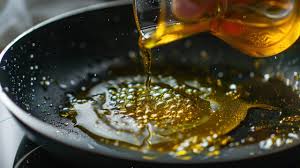If you were to ask me what food is the most toxic to our health, my answer would have been different throughout the last 2 decades. Early in my career, I would have said sugar. 10 years ago it would have been gluten. But now, although sugar and gluten are still at the top of the list, they’re not public enemy #1 in my opinion anymore. Now, the winner of that distinction is vegetable oil. The unhealthy imbalance of Omega 6 fatty acids to Omega 3’s is one of the leading contributors to the rampant inflammation in our country. And inflammation is at the root of our biggest killers: cancer, heart disease, and diabetes. The worst part is that these oils are used EVERYWHERE. Good luck eating anywhere outside your kitchen without exposure to vegetable oils. Every restaurant uses them to cook, even healthy restaurants. It’s in the deep fryer. It’s coating your chicken parmigiana. It’s in the taco shell. It’s in the salad dressing. It’s in the pie crust. The vegetables are cooked in it. Even the olive oil at the pizzeria is probably using a blend of olive and vegetable oil. Why, because it’s dirt cheap. It’s inside your house too. open your pantry, and check the ingredients in every potato chip, cracker, pretzel, cereal, cookie, tortilla chip, cake, roasted nut, dried fruit, etc. It’s everywhere, and it’s killing us. This article from draxe.com explains some of the detrimental mechanisms of vegetable oils, and suggestions for healthier alternatives:
Vegetable Oil: Healthy Cooking Oil or Harmful to Health?
July 12, 2024
- What Is Vegetable Oil?
- How Is It Made?
- Production and Consumption Rates
- Why You Should Avoid These Oils
- Vegetable Oil vs. Castor Oil
- Healthier Alternatives
Vegetable oil is a common ingredient that most of us have sitting on our kitchen shelves. However, there’s a lot of confusion about whether or not vegetable oils are actually good for you.
While some claim that vegetable oil is a good source of polyunsaturated fats, others point out that it’s also highly refined, heavily processed and rich in inflammatory omega-6 fatty acids.
So what is vegetable oil made of, and is vegetable oil healthy? Here’s what you need to know.
What Is Vegetable Oil?
Vegetable oil is a type of cooking oil that is extracted from a variety of different plants, including:
- Safflower
- Canola
- Palm
- Cottonseed
- Rice bran
- Sunflower
- Soybean
- Poppyseed
- Coconut
- Corn
- Sesame
- Peanut
- Olive
- Linseed
Many vegetable oil brands are also produced from a blend of several different types of oils, which helps cut costs for consumers and manufacturers alike.
Although many use vegetable oil for cooking and baking, it is also often used to make many other ingredients like margarine, condiments and salad dressings.
The vegetable oil structure is made up of glycerol and fatty acids. Unlike other fats, such as butter or ghee, most types are primarily composed of poly- and monounsaturated fats.
Vegetable oils have been around for centuries, and certain types, such as rapeseed, poppyseed and safflower, were even used in the Bronze Age in areas like the Middle East and Asia.
However, the modern refined oils on the market today were first created during the 20th century, thanks to advances in technology that improved the extraction process.
Today, this common cooking oil is one of the most popular ingredients used around the globe, and can be found in kitchen cabinets and pre-packaged and greasy foods alike.
How Is It Made?
How is vegetable oil made?
Oil is first removed from the plants, which can be done through either mechanical or chemical extraction.
Mechanical extraction involves crushing or pressing seeds to extract the oil. Chemical extraction, on the other hand, is a process that uses chemical solvents like hexane to remove the oil.
The oil is then purified, refined and chemically altered as needed to improve the taste, texture and shelf life of the final product.
Some oil is also hydrogenated, which is a chemical process that is used to turn liquid oils into a solid at room temperature. Hydrogenated vegetable oil is often preferred by manufacturers due to its longer shelf life, improved texture and enhanced flavor stability.
However, hydrogenated oil may also contain trans fatty acids, which can have detrimental effects on health.
The oil can also undergo other types of processing to produce products like brominated vegetable oil, a common food additive and emulsifier found in many soft drinks.
Production and Consumption Rates
Thanks to its versatility, widespread availability and the low vegetable oil price, this type of cooking oil has become increasingly popular within the last century.
According to a report by the the Food and Agriculture Organization of the United Nations, global edible vegetable oil that is allocated to food use increased by 48 percent between 1995 and 2011.
In 2024-25, “global production of vegetable oils will amount to 228.3 million tonnes. This would be a 4.5 million tonne rise compared to 2023/24. In other words, production could fully cover demand of presumably 224.9 million tonnes,” according to the USDA and Renewable Carbon News.
The use of these oils in food manufacturing, biodiesel production and other industrial products has increased the global demand for vegetable oil.
China, India, the United States, Brazil, Nigeria, Indonesia and Pakistan are considered the top consumers of vegetable oil globally.
Interestingly enough, palm oil, soybean oil, rapeseed oil and sunflower seed oil are among the most commonly consumed oils by consumers, and production of palm and soybean oil are on the rise. However, according to the recent USDA report, sunflower oil production may actually decline.
Why You Should Avoid These Oils
Several specific types of vegetable oils have been linked to health benefits. Coconut oil, for example, has been tied to higher levels of good HDL cholesterol, while olive oil has been associated with a lower risk of heart attack and stroke.
However, the vegetable oil found on most supermarket shelves is usually a blend of several different types of oils that have been highly processed and refined, which negates any of the potential vegetable oil benefits.
1. Omega-6
One of the main disadvantages of vegetable oil is its content of omega-6 fatty acids. Although we do need this important fatty acid in our diets, most of us consume far too much omega-6 and not nearly enough heart-healthy omega-3s.
In fact, although some experts recommend that we get equal parts omega-6 and omega-3 fatty acids in our diets, the ratio in the average Western diet is closer to 15:1. This is thought to increase inflammation and contribute to chronic disease.
2. Oxidation
Because of the vegetable oil chemical formula, these types of cooking oils are also easily oxidized. That means that they break down and deteriorate when exposed to heat.
This can increase the formation of free radicals, which are harmful compounds that cause inflammation and oxidative damage to cells.
3. Trans fats
Certain types may also come with some other adverse effects on health. Hydrogenated oils, for example, tend to be high in trans fats, a type of fatty acid that has been associated with a higher risk of heart disease, diabetes, obesity and even certain types of cancer.
4. Other disadvantages
Similarly, brominated vegetable oil is an emulsifier sometimes used in soft drinks that can also be incredibly harmful. According to studies in animals and humans, potential brominated vegetable oil side effects includeheadaches, fatigue, memory loss, impaired development, and alterations in heart, liver and thyroid health.
Vegetable oil can also be tricky to clean up and is notorious for clogging up sinks and causing sewage backup. Fortunately, there are several options for how to dispose of vegetable oil responsibly once you’ve finished using it.
Be sure to let it cool before pouring it into a non-breakable container with a resealable lid and disposing of it. You can also consider reusing the oil or dropping it off at your local recycling center or nearby restaurants instead.
Many people also wonder: Does vegetable oil go bad? Most varieties stay fresh for around six months to one year, depending on whether or not they have been opened.
Rancid oil tends to have a darker color, cloudy appearance and slightly bitter flavor.
Vegetable Oil vs. Castor Oil
Castor oil is a type of vegetable oil that is made by extracting the oil from castor beans. It’s often used as a substitute for vegetable oil in the food industry and is found in a variety of food additives and flavorings.
Certain types of castor oil are also used in food preservation to help extend the shelf life of grains and legumes.
Unlike vegetable oil, castor oil is rarely used as a cooking oil. Because of its high density, castor oil is not well-suited for cooking and is instead used as a natural remedy to promote regularity, enhance hair growth and moisturize the skin.
The vegetable oil smoke point is often higher as well. It can range between 350–520 degrees Fahrenheit depending on the specific type of oil.
Castor oil has a smoke point of 392 degrees Fahrenheit, with a boiling point of around 595 degrees Fahrenheit.
Healthier Alternatives
Although many specific types of vegetable oils are linked to an array of potential benefits and generally considered healthy oils, most vegetable oils sold commercially contain a mix of different seed oil varieties, all of which are highly processed and refined.
Here are a few healthy alternatives to choose instead:
1. Extra-virgin olive oil
This type of oil is a great alternative to other cooking oils, especially when drizzled over salads or used to add a punch of flavor to prepared dishes.
The main difference between olive oil vs. vegetable oil is that olive oil is higher in heart-healthy monounsaturated fats like oleic acid, which is thought to reduce levels of inflammation.
2. Coconut oil
Coconut oil has a mild flavor and smooth texture, which makes it a great choice for cooking and baking.
It’s also rich in medium-chain triglycerides (MCTs), which are fatty acids that have been shown to help increasemetabolism and boost brain function.
3. Avocado oil
With a smoke point of 520 degrees Fahrenheit, avocado oil is ideal for high-heat cooking.
The nutrition profile of avocado oil vs. canola oil vs. vegetable oil is much higher in monounsaturated fats and antioxidants like lutein, which plays an integral role in eye health.
4. Grass-fed butter
Grass-fed butter is a dairy product that is made by churning cream or milk. Compared to regular butter, grass-fed varieties are higher in omega-3 fatty acids as well as other healthy fats like conjugated linoleic acid.
Not only does grass-fed butter supply a number of important nutrients, but each tablespoon also contains a lower amount of calories than the amount of vegetable oil calories in the same size serving.
5. Ghee
Ghee is a type of clarified butter often used in Indian and Southeast Asian cuisines. It has a high smoke point, is rich flavor and has even been shown to protect against cancer cell growth in some animal models.
Final Thoughts
- What is vegetable oil? This common type of cooking oil is made from oils that have been extracted from plants, such as coconut, palm and safflower.
- However, many commercial varieties of vegetable oil are actually a blend of several different oils.
- After the oil is extracted, it’s purified, refined and chemically altered to improve the taste, texture and appearance.
- Is vegetable oil bad for you? The vegetable oil nutrition profile is loaded with omega-6 fatty acids, which can promote inflammation and contribute to chronic disease.
- It’s also easily oxidized, and certain types, such as hydrogenated or brominated oils, are also associated with several adverse effects on health.
- Coconut oil, grass-fed butter, ghee, avocado oil and extra-virgin olive oil are all excellent alternatives for a healthy, well-rounded diet.


